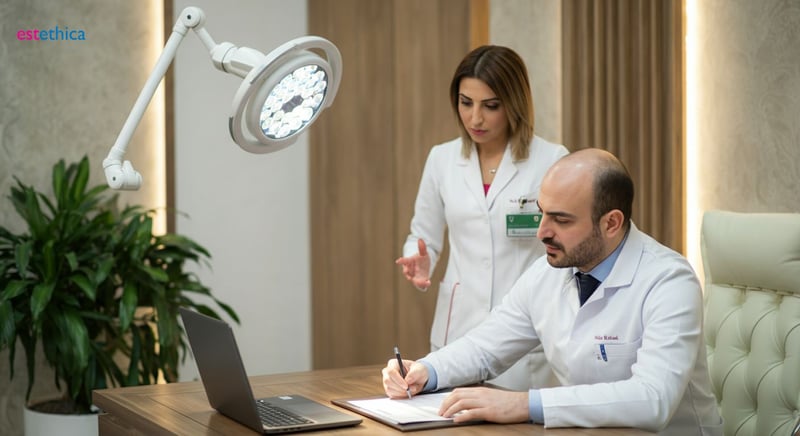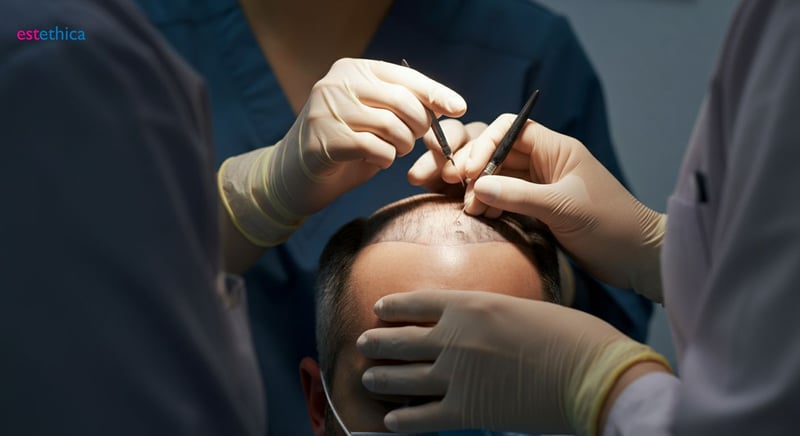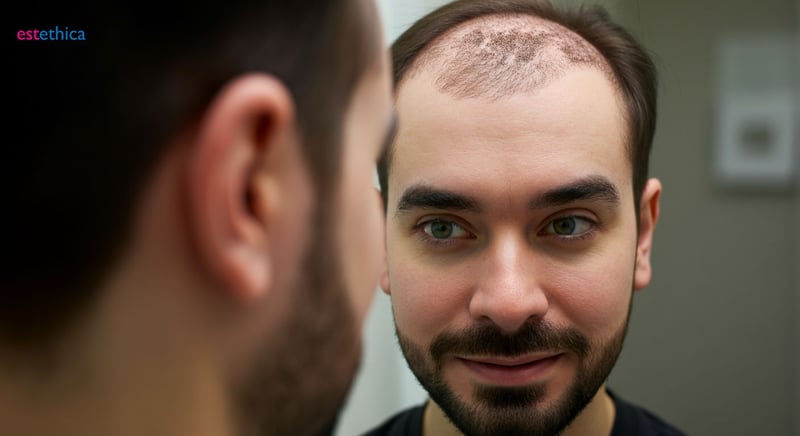Unlock Your Hair's Potential: A Complete Guide to Hair Transplant
Explore the journey to hair restoration with cutting-edge solutions like FUE and FUT designed to rejuvenate and boost confidence.
The journey to restoring one's hair can be both an exhilarating and enlightening experience. In recent years, hair transplants have skyrocketed in popularity, offering individuals a chance to reclaim their desired hair density and confidence. With procedures becoming more advanced and accessible, understanding the intricacies of hair transplants is paramount for anyone considering this transformative procedure. Whether grappling with hair loss due to genetics, health conditions, or environmental factors, hair transplants provide a viable solution with promising results. This comprehensive guide delves into the key elements of hair transplants, exploring the root causes of hair loss, the distinct techniques available, and essential aftercare tips to ensure optimal results. Join us as we unlock the full potential of your hair.
Understanding Hair Loss: Identifying the Root Cause
Deciphering the Genetic Predisposition to Hair Loss
Genetics play a pivotal role in determining an individual's susceptibility to hair loss, particularly in cases of male pattern baldness. For many, understanding this genetic link is the first step toward seeking appropriate hair transplant solutions. This hereditary factor often dictates the age of onset, pattern, and progression of hair thinning. While not always a guarantee, a family history of baldness significantly raises the likelihood.
- Understanding lineage: Examine your family history to gauge your predisposition to hair loss.
- Genetic counseling: Consider genetic testing for insights into your risk factors.
- Early intervention: Early detection allows for preventative measures, such as topical treatments or lifestyle adjustments.
Hormonal Imbalances and Their Impact on Hair Health
Hormonal fluctuations, especially during life stages like puberty, pregnancy, and menopause, can significantly impact hair health, often leading to noticeable hair loss. For instance, an imbalance in thyroid hormones can disrupt the hair growth cycle, leading to thinning or shedding. Similarly, changes in estrogen levels can affect the density and vitality of hair. Addressing these hormonal imbalances becomes crucial in mitigating hair loss and restoring healthy hair growth, potentially in conjunction with treatments like hair restoration.
- Hormone level assessment: Seek medical evaluation to accurately identify any hormonal disparities.
- Targeted treatments: Opt for hormone replacement therapy or medication, as guided by healthcare professionals.
- Nutritional support: Adopt a diet rich in hair-nourishing elements, like vitamins and minerals.

Hair Restoration Techniques: FUE vs. FUT - Which is Right for You?
Understanding the FUE Procedure and Its Advantages
Follicular Unit Extraction (FUE) has revolutionized the field of hair transplant, offering a minimally invasive alternative to traditional methods. FUE involves the extraction of individual hair follicles directly from the scalp, which are then transplanted to areas affected by hair loss treatment. The key benefit of FUE is its precision, allowing surgeons to select the healthiest follicles for transplantation.
- No linear scar: FUE leaves tiny, virtually undetectable scars, making it ideal for those who prefer shorter hairstyles.
- Faster recovery: Patients typically experience a quicker recovery compared to FUT, with less discomfort during the healing process.
- Natural results: The precise nature of FUE allows for strategic placement of follicles, resulting in a natural-looking hairline.
Exploring the FUT Procedure and Patient Suitability
Follicular Unit Transplantation (FUT), also known as strip harvesting, is another effective method of hair restoration. This technique involves removing a strip of scalp from the back of the head, from which individual follicular units are then extracted and transplanted. FUT is often recommended for patients requiring a large number of grafts in a single session. FUT can be an effective solution for comprehensive coverage.
- High graft yield: FUT typically yields a higher number of grafts compared to FUE, making it suitable for extensive hair restoration.
- Cost-effective: In some cases, FUT may be more cost-effective than FUE, especially when a large number of grafts are needed.
- Established technique: FUT has a long history of success and is a well-established method for addressing male pattern baldness.

The Hair Transplant Journey: What to Expect Before, During, and After
Navigating the Pre-Surgery Consultation Phase
The journey toward a hair transplant begins well before the procedure itself, with a comprehensive consultation process designed to set realistic expectations and tailor the treatment to your specific needs. This crucial phase involves detailed discussions with a hair restoration specialist who will evaluate your hair loss pattern, assess your overall health, and explain the various options available, including Follicular Unit Extraction (FUE) and Follicular Unit Transplantation (FUT). It's a time to ask questions, understand the potential outcomes, and align on a strategic approach for your hair loss treatment.
- Medical history review: A thorough examination of your medical background to ensure suitability.
- Scalp examination: Assessing the condition of your scalp and hair follicles.
- Personalized planning: Crafting a bespoke treatment plan that caters to individual needs.
Mastering Post-Operative Care
The success of a hair transplant hinges significantly on diligently following post-operative care instructions. Proper aftercare is essential for optimizing healing and ensuring the survival of the newly transplanted follicles. This involves carefully adhering to guidelines regarding washing, medication, and activity restrictions. Avoiding strenuous activities during the initial recovery phase is critical, as is protecting the scalp from direct sunlight. Consistent adherence to these protocols fosters an environment conducive to the successful integration of the new hair, increasing the likelihood of a satisfactory outcome. By closely following the advice of your estethica Global medical team, you actively contribute to your journey toward renewed hair growth. Achieving successful hair implants relies heavily on meticulous attention to aftercare.
- Gentle washing: Use a recommended shampoo to cleanse the scalp gently.
- Medication adherence: Take prescribed medications to prevent infection and reduce swelling.
- Sun protection: Shield the scalp from direct sunlight to protect the transplanted area.

Maintaining Your Hair Transplant: Long-Term Care for Lasting Results
Essential Post-Transplant Hair Care Practices
The period following a hair transplant is crucial for ensuring the longevity and success of the procedure. Proper hair care is not just about aesthetics; it's about nurturing the transplanted follicles to thrive in their new environment. This involves a multifaceted approach, including using specific shampoos, following gentle washing techniques, and avoiding harsh chemicals. According to experts, approximately 90% of transplanted hair will successfully grow if these practices are consistently followed.
- Use gentle shampoos: Opt for sulfate-free, pH-balanced shampoos to cleanse without stripping natural oils.
- Avoid harsh treatments: Refrain from using styling products with alcohol or strong chemicals that can damage new follicles.
- Handle with care: Be gentle when brushing or combing your hair to prevent dislodging grafts.
Lifestyle Adjustments for Sustained Hair Health
Beyond direct hair care, adopting certain lifestyle adjustments can significantly contribute to the sustained health and appearance of your hair restoration. A balanced diet rich in vitamins and minerals provides the necessary nutrients to strengthen hair follicles from within. Managing stress levels is also key, as chronic stress can exacerbate hair loss treatment. Regular check-ups with your estethica Global clinic can help monitor your progress and address any concerns proactively. Embracing a holistic approach to wellness can ensure that your hair implants not only look good but are also healthy and resilient.
- Balanced diet: Incorporate foods rich in vitamins, minerals, and proteins for healthy hair growth.
- Stress management: Practice relaxation techniques such as yoga or meditation to reduce stress-related shedding.
- Regular check-ups: Attend follow-up appointments at estethica Global to monitor the health of your transplanted hair and receive personalized advice.
Precision FUE and FUT Techniques for Natural-Looking Hair Restoration
Personalized Treatment and Meticulous Post-Operative Care for Optimal Graft Survival
Frequently Asked Questions
What are the primary causes of hair loss that can be addressed with a hair transplant?
What are the main differences between FUE (Follicular Unit Extraction) and FUT (Follicular Unit Transplantation) for hair restoration?
What does the hair transplant journey entail, from the initial consultation to post-operative care?
How can I ensure the long-term success and health of my hair transplant?
Ready to discover your healthiest, most beautiful self with estethica's personalized aesthetic solutions?
📞 Call Now for a Free Consultation!